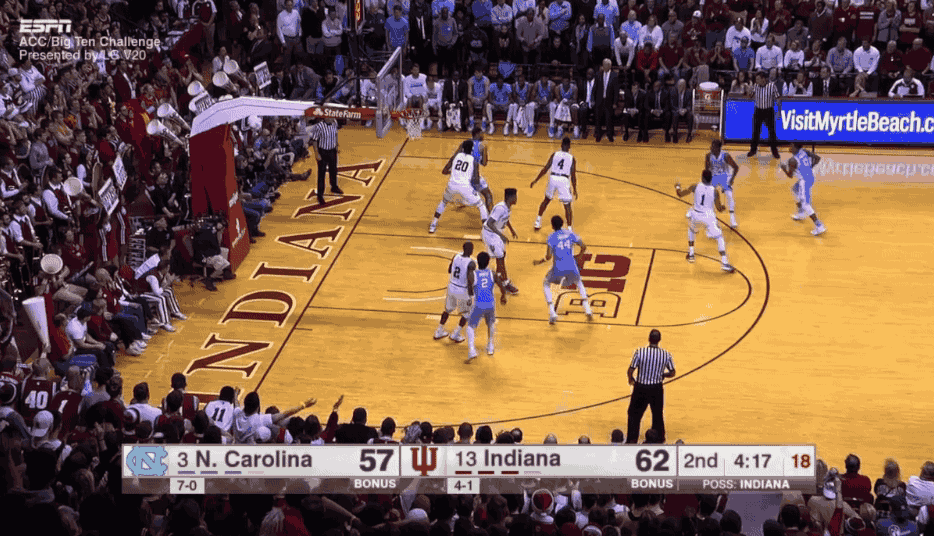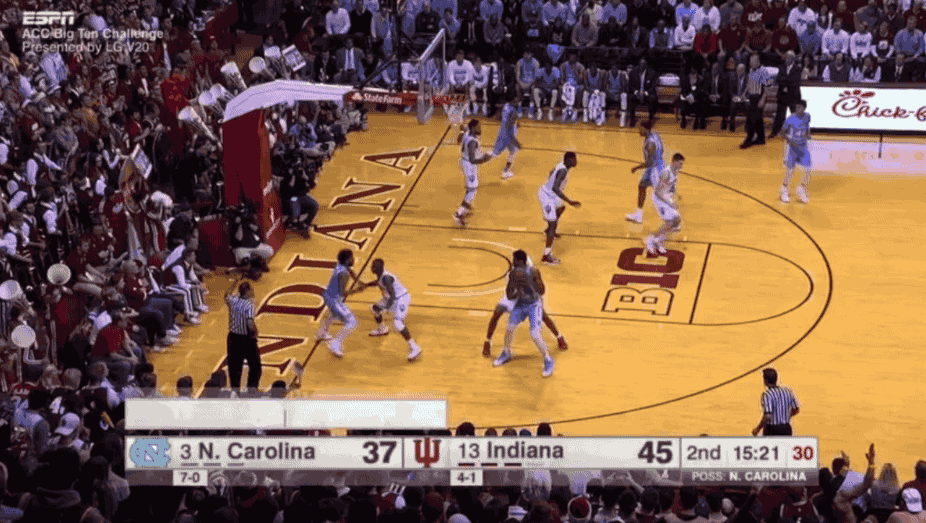Four Factor Friday: Dec. 2, 2016
The third addition of Four Factor Friday is specific. Since the Tar Heels only played 1 game in the last week, we’ll breakdown the loss to Indiana across all four factors:
- Effective field goal percentage
- Turnover percentage
- Offensive rebounding
- Free throw rate
eFG%
Carolina posted a 44.3% offensive effective field goal percentage. The Tar Heels made 24 of 61 shots. Only 6 of those 24 shots were from behind the 3-point line.
eFG% = (.5 x 6) + 24 / 61 x 100 = 44.3%
UNC’s shot selection wasn’t all that strong early. The first shot attempt of the game by Nate Britt with the shot clock winding down set the tone.

Give credit to Indiana’s defense. The Hoosiers held the Tar Heels scoreless in 7 straight possessions en route to building an early 17-point lead. Senior Isaiah Hicks didn’t attempt a single shot in first 20 minutes, and Joel Berry II was 1-for-6 from the field in the 1st frame.
UNC did get some easier buckets in the 2nd half. The first 3 shots of the second half were a layup from Justin Jackson, layup by Kennedy Meeks, and then a dunk by Meeks.
This surge cut the Hoosiers’ lead to 4 with under 5 minutes to play. Indiana added a free throw to extend the lead to 62–57 before a critical Tar Heel possession.

Kenny Williams took a long 2-point shot that went in-and-out. If Williams’ shot falls, the Hoosier lead is cut to 3 with a media timeout coming soon.
Instead, Indiana drilled a 3-point shot on its next possession, and the lead went back to 8 points.
Carolina’s previous 3 shots prior to that possession all came from close range, including a runner in the lane from Berry II and a Tony Bradley fast-break dunk. Williams shot selection wasn’t awful here, however, the Tar Heels might have preferred higher percentage shot in the paint?
There’s a fair statistical chance that last night will remain UNC’s worst showing on offense in all of 2016-17.
— John Gasaway (@JohnGasaway) December 1, 2016
Hoosiers, I salute you.
It wasn’t pretty on offense, but again give some credit to Indiana. UNC only scored 0.93 points per possession (PPP) Wednesday night. Its lowest PPP since scoring .92 in a loss to Louisville last season.
Indiana posted a 55.8% effective field goal percentage. The Hoosiers knocked down 8 shots from behind the 3-point line, and we’re 25–of-52 from the field overall.
eFG% = (.5 x 8) + 25 / 52 x 100 = 55.8%
No surprise that’s good for the highest field eFG% goal percentage allowed by UNC this season (Dec. 2, 2016).
Indiana got off to a fast start making its first 3 shots, including a pair from behind the 3-point line. The backcourt Carolina ran with the most in the Maui Invitational, Berry and Williams, only played 26 seconds together in the first half.
Berry picked up a couple of fouls in the first 5 minutes. And Williams, who did not start, struggled in the first half playing only 5 minutes. This left a lot of folks curious, and for good reason. Because Williams is known as one of the Tar Heels’ better defenders.
As Adrian Atkinson calls it, the Kenny Williams effect. Lineup data from Atkinson’s newsletter shows opponents prior to Indiana posting an eFG% of 47% against a backcourt of Berry-Britt versus 37% against a Berry-Williams backcourt.
Turnover Percentage (TO%)
Carolina and Indiana’s matchup featured roughly 71 possessions Wednesday. In those 71 possessions, UNC committed 12 turnovers and Indiana turned it over 16 times.
Carolina posted a 16.7 TO%, turning it over on about 17% of their possessions. The Tar Heels avoided turnovers a bit better than Indiana’s 22.2% clip.
8 of UNC’s 12 turnovers came in the 1st half, yet another reason why the Hoosiers led by as many as 17 at one point.
Indiana’s wasted possessions did let Carolina hang around, but in the end, the Hoosiers were able to close it out down the stretch.
Offensive Rebounding (OR%)
UNC and Indiana both rank in the top-10 in the country in offensive rebounding percentage according to KenPom.com.
Carolina edged Indiana Wednesday snagging 13 offensive rebounds to IU’s 29 defensive rebounds, good for a OR% of 30.95%.
OR% = 13 / (13+ 29) = 30.95
The Hoosiers pulled down 8 offensive rebounds to UNC’s 24 defensive rebounds, or a 25% offensive rebounding percentage.
UNC did a solid job on the glass, however, this stat is somewhat misleading. In order for Indiana to have a chance to get offensive rebounds, they’ve got to miss shots.
Remember, the Hoosiers shot almost 50% from the field in the 9-point victory. UNC shot a lower percentage, giving it more opportunities to grab offensive boards.
Free Throw Rate
Ugly night at the free throw line for Carolina. It attempted 22 free throws and 61 total shots, translating to a 36.07% FTRate.
FTRate = 22 / 61 x 100 = 36.07%
UNC got to the line a fair amount. But the Tar Heels could have added some much needed points from the charity stripe, and even more attempts.
3-point game if UNC is making all of its free throws. Missed six and would have earned three more if not for 3 missed front end of 1&1s
— R.L. Bynum (@RL_Bynum) December 1, 2016
Carolina made only 13 of 22 free throws and missed the front-end of 3 one-and-one attempts in the 1st half Wednesday.
Indiana on the other hand, registered a 51.9% FTRate. IU attempted 27 free throws and 52 field goals.
Carolina committed some silly fouls, like this one from Isaiah Hicks about 90 feet from the opponents’ basket.

The 27 free throw attempts are the most by a Tar Heel opponent this season. Carolina opponents only posted more than 27 free throw attempts 3 times in 40 games in the 2015–16 season.
Free throw rate is a maddening metric for UNC lately. Roy Williams wants his team to make more free throws than its opponent attempts because that often leads to a successful season. And Carolina hasn’t done that since the 2011–12 season.
Prior to the Indiana game, Carolina had made 135 made free throws to its oppopents’ 105 attempted free throws (+30 margin).
After the loss to IU, Carolina has now made 148 free throws to its opponents’ 132 free throw attempts (+16 margin).
In short, Carolina rebounded offensively and avoided turnovers a little bit better than Indiana, but the Hoosiers shot a higher percentage and got to the foul line more often building a big lead early. That’s a recipe for UNC’s first loss of the season, and an impressive performance by IU.
The Tar Heels return to Chapel Hill for a 3-game homestand starting with Radford Sunday, before another showdown with a top-opponent in Kentucky on Dec. 17 in Las Vegas.